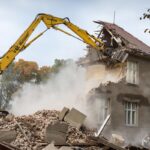Asbestos, a naturally occurring mineral known for its strength and resistance to heat and corrosion, was once widely used in construction materials, including drywall, also known as gypsum board or plasterboard.
However, due to its harmful health effects, the use of asbestos in construction materials has been heavily regulated and, in many cases, banned. This article explores the prevalence of asbestos in drywall, the risks associated with it, and the steps to manage or mitigate these risks.
Historical Use of Asbestos in Drywall
Asbestos was added to drywall compounds from the early 20th century until the late 1970s in the United States and other parts of the world. Its fire-resistant properties made asbestos an attractive additive for drywall, especially in areas prone to fire hazards. The most common use was in the joint compound or “mud” used to finish the drywall installation, rather than in the drywall sheets themselves.
Current Prevalence
Today, the presence of asbestos in drywall is far less common, especially in materials produced after the 1980s. Many countries have implemented strict regulations regarding the use of asbestos in construction materials. In the United States, for example, the Environmental Protection Agency (EPA) and the Occupational Safety and Health Administration (OSHA) have set stringent guidelines to limit the use of asbestos in construction and to manage its removal safely.
However, asbestos may still be found in older buildings, particularly those constructed or renovated before the 1980s. It’s crucial for homeowners, contractors, and workers involved in the renovation or demolition of older buildings to be aware of the potential for asbestos-containing materials (ACMs), including drywall.
Health Risks
Asbestos exposure is linked to several serious health conditions, including asbestosis (a lung disease caused by inhaling asbestos fibers), lung cancer, and mesothelioma (a rare form of cancer primarily affecting the lining of the lungs or abdomen). The risk of these diseases increases with the amount and duration of exposure to asbestos fibers.
Identifying and Managing Asbestos in Drywall
Identifying asbestos in drywall can be challenging because it is not possible to determine the presence of asbestos by appearance alone. If a building was constructed or renovated before the 1980s, it’s advisable to assume that asbestos could be present and take appropriate precautions. Testing by a certified asbestos abatement professional is the only way to confirm its presence.
If asbestos is found, the safest approach is to leave it undisturbed if it’s in good condition. Asbestos is most dangerous when it’s friable (easily crumbled by hand), releasing fibers into the air. If the asbestos-containing material must be disturbed or is in poor condition, professional asbestos removal or encapsulation is necessary to prevent exposure.
While the use of asbestos in drywall is much less common today due to strict regulations, the potential for encountering asbestos in older buildings remains. Understanding the historical use of asbestos, recognizing the health risks associated with exposure, and knowing how to manage or mitigate these risks are essential for ensuring the safety of those involved in the renovation or demolition of older buildings. Professional testing and abatement are key steps in managing the risks associated with asbestos in drywall.
Preventative Measures and Best Practices
For homeowners, contractors, and professionals dealing with older constructions, awareness and precautionary measures are paramount to ensure safety. Here are some best practices to follow:
Education and Training
Asbestos Awareness: Individuals involved in construction, demolition, or renovation should receive training on asbestos recognition and safe handling practices.
Regulatory Compliance: Familiarize with local and national regulations regarding asbestos handling, disposal, and worker protection.
Professional Testing
Hire Experts: Before any renovation or demolition work in buildings constructed before the 1980s, hire certified asbestos professionals for inspection and testing.
Sampling and Analysis: Professionals will take samples of suspected materials in a safe manner and analyze them in a lab to determine the presence of asbestos.
Safe Handling and Removal
Leave it Undisturbed: If asbestos-containing materials (ACMs) are in good condition and not in the way of renovation works, it’s often safest to leave them undisturbed.
Professional Abatement: For removal or disturbance of ACMs, employ licensed asbestos abatement contractors who have the equipment and training to do the job safely.
Proper Disposal: Asbestos waste must be handled and disposed of according to local regulations to prevent exposure to workers and the public.
Personal Protection
Personal Protective Equipment (PPE): Workers handling asbestos should use appropriate PPE, including respirators, gloves, and disposable coveralls.
Containment and Ventilation: Use containment measures to prevent asbestos fibers from spreading and ensure adequate ventilation in the work area.
Regular Monitoring and Maintenance
Regular Inspections: Periodically inspect ACMs in buildings for signs of wear or damage and take appropriate action if necessary.
Maintenance Records: Keep detailed records of the location, condition, and management actions taken for ACMs within a building.
Legal and Ethical Considerations
The management of asbestos is not only a safety concern but also a legal and ethical one. Property owners and employers are obligated to protect occupants, workers, and the public from asbestos exposure risks. Non-compliance with regulations can lead to significant legal liabilities and health repercussions for affected individuals. Ethically, it is imperative to prioritize human health and safety over cost-saving measures that compromise safe asbestos handling and removal.
Looking Forward
With ongoing advancements in construction materials and growing awareness of asbestos-related health risks, the prevalence of asbestos in modern buildings is decreasing. However, the legacy of its past use remains a significant concern. Continuing education, adherence to best practices, and technological advancements in asbestos detection and removal are vital to mitigating this legacy risk.
As we move forward, it’s crucial that we continue to address the challenges posed by asbestos in drywall and other building materials with the utmost seriousness, ensuring a safer environment for all.
Frequently Asked Questions (FAQs) about Asbestos in Drywall
How can I tell if my drywall contains asbestos?
It’s difficult to determine if drywall contains asbestos just by looking at it. If your home or building was constructed or renovated before the 1980s, there’s a chance it might contain asbestos. The only way to be sure is to have a sample of the drywall tested by a certified asbestos professional.
Is it safe to remove asbestos-containing drywall by myself?
No, it’s not recommended to remove asbestos-containing materials (ACMs) yourself. Asbestos removal requires specialized training, equipment, and safety protocols to prevent the release of asbestos fibers into the air. It’s best to hire a licensed asbestos abatement contractor to handle the removal safely.
What should I do if I accidentally disturb drywall that contains asbestos?
If you suspect you’ve disturbed asbestos-containing drywall, stop work immediately and isolate the area to prevent the spread of any dust or fibers. Do not attempt to clean up the material yourself. Contact an asbestos removal professional to assess the situation and safely clean up and remove the material.
Can painting or covering asbestos-containing drywall make it safe?
Encapsulation, which involves covering or sealing asbestos material with a protective barrier, is a method used to prevent fiber release from ACMs. Painting or covering asbestos-containing drywall can be part of an encapsulation strategy, but it should only be done after consulting with an asbestos professional to ensure it’s done safely and effectively.
How much does it cost to remove asbestos from drywall?
The cost of asbestos removal can vary widely depending on the extent of the asbestos-containing material, the method of abatement, and regional labor rates. It’s important to get several quotes from licensed asbestos removal contractors to understand the potential costs.
Are there any health risks from living in a house with asbestos-containing drywall if it’s not disturbed?
Asbestos poses health risks when its fibers are inhaled. If asbestos-containing drywall is in good condition and not disturbed, it generally does not present an immediate health risk. However, it’s important to monitor the condition of the material and manage it appropriately to prevent future disturbances.
How is asbestos in drywall legally disposed of?
Asbestos waste, including contaminated debris and protective clothing used during removal, must be disposed of according to local and federal regulations. This typically involves sealing the material in leak-tight containers and disposing of it at approved waste disposal sites. Licensed asbestos abatement contractors will handle this process as part of the removal service.
Are new drywall products completely free of asbestos?
Yes, new drywall and joint compounds manufactured in countries with asbestos regulations, including the United States, do not contain asbestos. However, it’s always a good practice to check the product specifications or consult with the manufacturer if you have concerns about specific products.
Understanding the complexities of asbestos in drywall and taking appropriate measures for its safe handling and removal are essential for maintaining a safe living and working environment. Always prioritize safety and compliance with local regulations when dealing with asbestos-related issues.






